Nourishing recovery: Unleashing the power of nutrition to benefit active aging
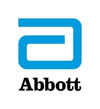
Proper nutrition is a cornerstone of well-being, essential for optimal performance, injury prevention, and swift recovery. Just as quality fuel enhances an engine, a balanced diet fuels the body. By providing necessary nutrients, individuals can boost endurance and performance in various activities. Nutrition also safeguards muscles, bones, and tissues, reducing injury risks. Moreover, it aids post-activity or post-surgical recovery by minimizing inflammation and replenishing energy stores. Nutrition is a vital support system for overall health, readying the body for action and ensuring lasting vitality.
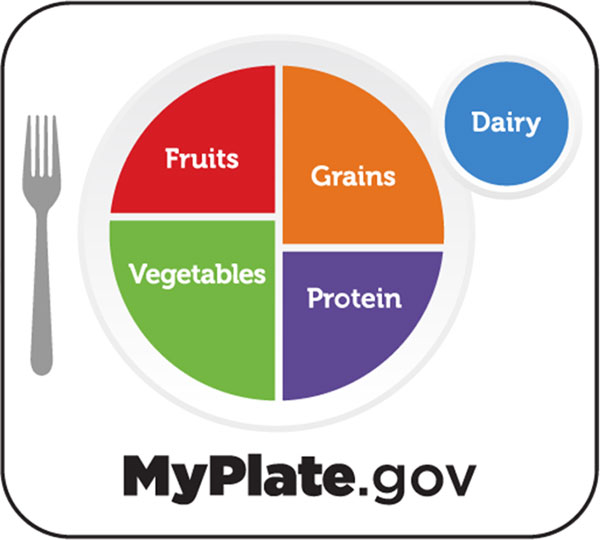
A healthy diet includes all the food groups: fruits, vegetables, protein-rich foods, grain and dairy. Eating a variety of foods from every food group is essential for healthy aging. The Older Adult MyPlate serves as a key tool in empowering older adults to make informed dietary choices. It’s based on the latest scientific evidence from the Dietary Guidelines for Americans (DGAs), which is updated every five years. Older Adult MyPlate is a great resource for eating healthy on a budget, learning about general nutrition and activity guidelines, and more.
ENHANCED RECOVERY THROUGH PROPER NUTRITION
Active aging can be hampered by illness and injury. Recovery, be it from acute illness, recent hospitalization, sports-related sprains, wounds from surgery, or other injuries, demands specific attention to nutrition. Proper nutrition plays a key role in effective recovery and healing. Let's explore some important nutrients that will help older adults get “back in the game.”
Protein is pivotal
All adults require more protein as they age to preserve muscle mass. Studies have documented that muscle mass decreases about 3% to 8% per decade after the age of 30 and decreases at an even faster rate after the age of 60. Approximately 40% of healthy adults over 50 years of age do not consume the protein they need, and those older adults are more likely to consume less than the recommended level of other nutrients.
Eating enough protein is essential for growth and repair of damaged tissues. During the recovery process, older adults can have higher protein needs. For example, wound healing after surgery can increase protein requirements by 250% and calorie requirements by 50% and in the case of immobility due to injury, protein needs can increase to 2.0g/kg/day or higher. Reaching that protein goal after an immobilizing injury can minimize loss of muscle and strength during immobilization.
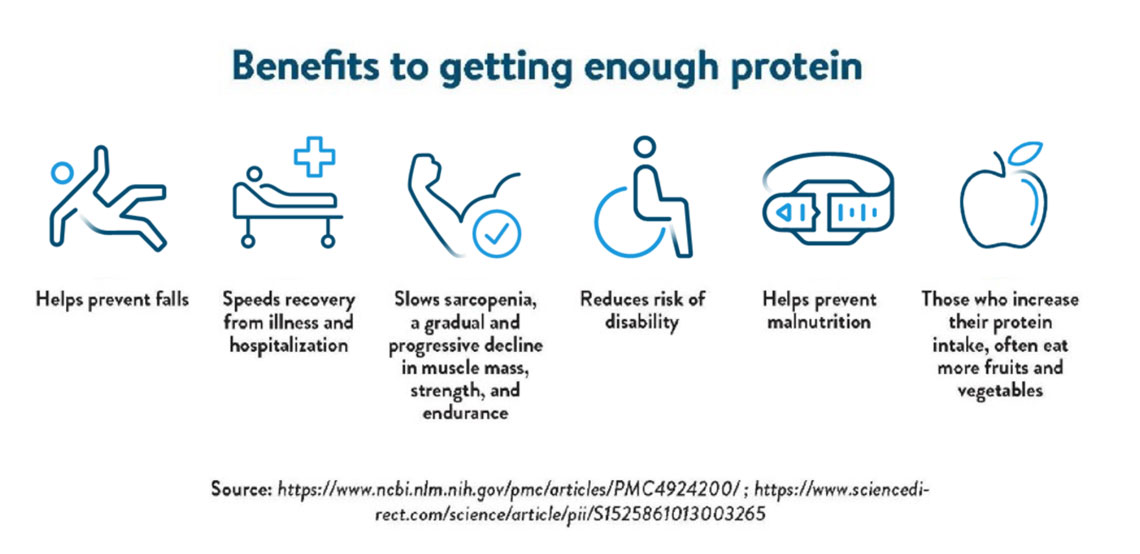
Eating about 25–30 grams of protein per meal stimulates maximum muscle protein synthesis in adults. To meet this level, older adults need to include protein rich foods at every meal. Many food groups contain protein-rich foods. Animal sources of protein (meats, seafood, dairy) provide the highest-quality protein.
Plants can provide protein too but differ in nutritional quality. One ounce of nuts contains 5–7 grams of protein, depending on the variety. Soybeans, beans, lentils and other legumes are good sources of protein, too, providing 15–30 grams of protein per cooked cup. Other vegetables with protein include green peas (about 9 grams of protein per cooked cup) and broccoli, spinach, asparagus, artichokes, potatoes, sweet potatoes and Brussels sprouts (which typically contain 4–5 grams of protein in each cooked cup).
Although there are plenty of ways to include protein-rich foods in the diet, oral nutrition supplements are also an excellent source of protein that require no preparation. They can be added to meals or taken between meals for extra protein.
Other resources on Protein
- Short video on building muscle with protein
- Short course on nutrition and protein needs for recovery
Other necessary nutrients
While overall nutrition is essential, focusing on specific dietary requirements can further aid in the recovery journey. Including foods rich in vitamins A, C, and E, along with zinc and other nutrients, can boost the immune system and enhance wound healing capabilities (see Table). Discussions with registered dietitian nutritionists can help determine if additional nutrition, such as specialized nutrition products that support wound healing, are needed to meet individual needs. Read more about how good nutrition can support immune health.
| Nutrient | Function in Recovery |
|---|---|
| Arginine | Essential amino acid with major role in healing process; helps increase blood flow and oxygen to wound, is building block for proteins (which can contribute to wound healing), helpful for muscle injury repair |
| Glutamine | Essential amino acid with multiple functions; stimulates collagen production for rebuilding and wound healing, regulates nitrogen metabolism for adequate protein formation, supports immune system health |
| HMB | HMB (beta-hydroxy-beta-methylbutyrate) comes from leucine (amino acid); helps produce new tissue by slowing down muscle breakdown, stabilizes muscle cell membrane |
| Micronutrients | Vitamins C, E, B12 and the mineral Zinc are particularly important for wound healing process |
Malnutrition slows recovery and wound healing. Up to one in two older adults are at risk of or have malnutrition. Malnutrition slows injury recovery and hampers the intricate processes of wound healing. Consuming too little of crucial nutrients can extend healing times and heighten the risk of infections and complications.
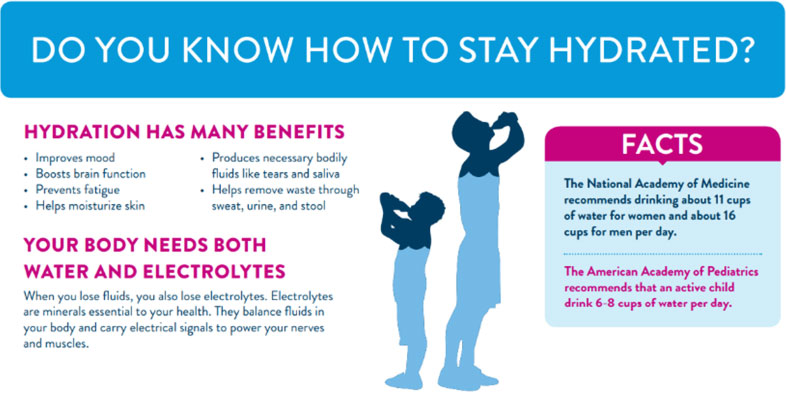
Hydration helps too
Good hydration is mandatory for peak exercise performance and overall health. Fluids help regulate body temperature, lubricate joints, and aid in the elimination of waste products, and provide additional benefits too (see figure and this hydration infographic).
Drinking fluids before, during, and after activities reduces muscle fatigue and accelerates the body's self-repair process following physical activity, illness, and acute injury. Hydrating after activities helps the body recover water lost through sweating. While electrolytes are also lost through sweat, typically, a balanced snack is enough to replenish electrolytes after most exercise sessions.
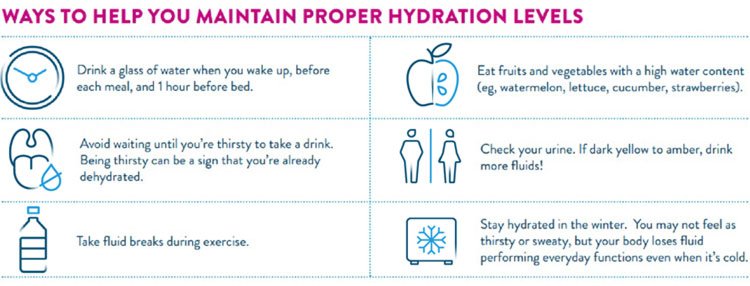
Thirst sensation can decrease with age, leading older adults to be less aware of their fluid needs. So, it’s necessary to keep tabs on their hydration levels. Water is ideal for hydration but mix it up to avoid boredom. Make that glass of clear liquid a bit more interesting by dropping in sliced fruit, adding a little fruit juice, or brewing a cup of non-caffeinated tea. Cow’s milk or milk alternatives offer hydration and nutrition as well. See extra ideas in the figure and this infographic. The fluid in caffeinated drinks typically balances the diuretic effect (e.g. increased urination from) of typical caffeine levels in beverages. Yet too much caffeine can be dehydrating or interfere with certain medications, so keep an eye on how much caffeinated teas, coffees, and other beverages older adults consume.
Proper nutrition is fundamental for healthy aging and wound healing and recovery. By giving our bodies the right nourishment, we can help them heal faster and better. Nutrients like proteins, vitamins, and minerals act as the building blocks for repairing our tissues and boosting our immune system. Failing to meet nutritional needs not only can hinder the wound healing process, but also make delayed healing or complications more likely. So, on the sometimes “long road to recovery,” let’s help make it shorter by remembering the importance of good nutrition.
Check out more nutrition and health resources, including free reflective learning continuing medical education and interprofessional continuing education available through the Abbott Nutrition Health Institute.

Share




